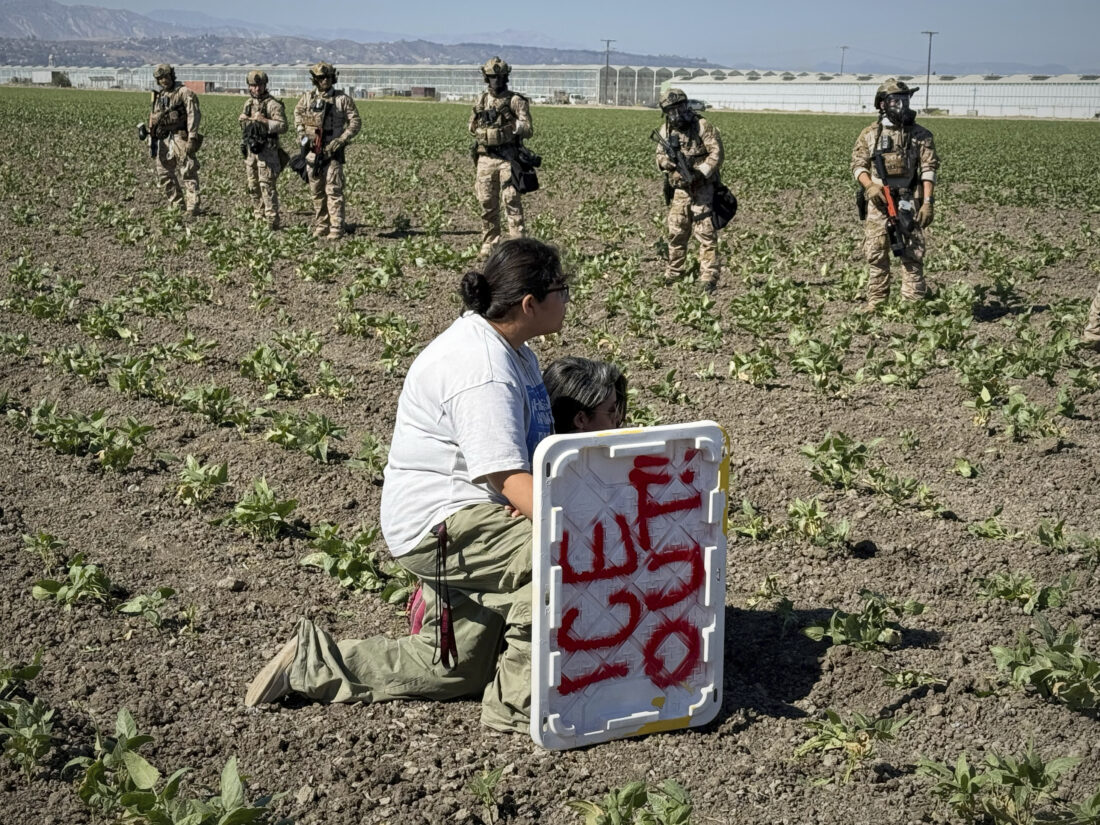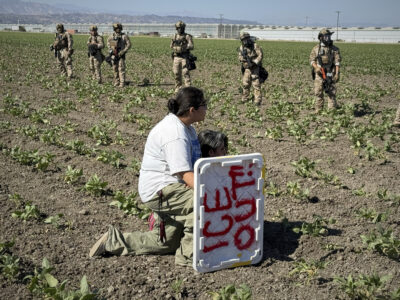1.2 million immigrants gone from US labor force, preliminary data shows

A demonstrator kneels in front of federal agents in a farm field during an immigration raid in Camarillo, Calif., on July 10. (AP Photo/Michael Owen Baker, file)
It’s tomato season and Lidia is harvesting on farms in California’s Central Valley.
She is also anxious. Attention from U.S. Immigration and Customs Enforcement could upend her life more than 23 years after she illegally crossed the U.S.-Mexico border as a teenager.
“The worry is they’ll pull you over when you’re driving and ask for your papers,” said Lidia, who spoke to The Associated Press on condition that only her first name be used because of her fears of deportation. “We need to work. We need to feed our families and pay our rent.”
As parades and other events celebrating the contributions of workers in the U.S. were held Monday for the Labor Day holiday, experts said President Donald Trump’s stepped-up immigration policies are impacting the nation’s labor force.
More than 1.2 million immigrants disappeared from the labor force from January through the end of July, according to preliminary Census Bureau data analyzed by the Pew Research Center. That includes people who are in the country illegally as well as legal residents.
Immigrants make up almost 20% of the U.S. workforce and that data shows 45% of workers in farming, fishing and forestry are immigrants, according to Pew senior researcher Stephanie Kramer. About 30% of all construction workers are immigrants and 24% of service workers are immigrants, she added.
The loss in immigrant workers comes as the nation is seeing the first decline in the overall immigrant population after the number of people in the U.S. illegally reached an all-time high of 14 million in 2023.
“It’s unclear how much of the decline we’ve seen since January is due to voluntary departures to pursue other opportunities or avoid deportation, removals, underreporting or other technical issues,” Kramer said. “However, we don’t believe that the preliminary numbers indicating net-negative migration are so far off that the decline isn’t real.”
Trump campaigned on a promise to deport millions of immigrants working in the U.S. illegally. He has said he is focusing deportation efforts on “dangerous criminals,” but most people detained by ICE have no criminal convictions. At the same time, the number of illegal border crossings has plunged under his policies.
Pia Orrenius, a labor economist at the Federal Reserve Bank of Dallas, said immigrants normally contribute at least 50% of job growth in the U.S.
“The influx across the border from what we can tell is essentially stopped, and that’s where we were getting millions and millions of migrants over the last four years,” she said. “That has had a huge impact on the ability to create jobs.”
Just across the border from Mexico in McAllen, Texas, corn and cotton fields are about ready for harvesting. Elizabeth Rodriguez worries there won’t be enough workers available for the gins and other machinery once the fields are cleared.
Immigration enforcement actions at farms, businesses and construction sites brought everything to a standstill, said Rodriguez, director of farmworker advocacy for the National Farmworker Ministry.
“In May, during the peak of our watermelon and cantaloupe season, it delayed it. A lot of crops did go to waste,” she said.
Kramer, with Pew, warns about the potential impact on health care. She says immigrants make up about 43% of home health care aides.
The Service Employees International Union represents about 2 million workers in health care, the public sector and property services. An estimated half of long-term care workers who are members of SEIU 2015 in California are immigrants, said Arnulfo De La Cruz, the local’s president.
“What’s going to happen when millions of Americans can no longer find a home care provider?” De La Cruz said. “What happens when immigrants aren’t in the field to pick our crops? Who’s going to staff our hospitals and nursing homes?”




